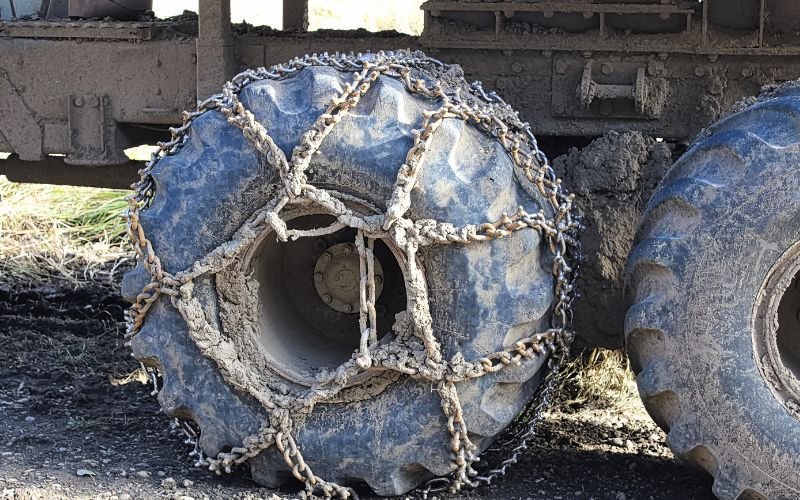Truck Tire Chains Winter Safety Guide for Drivers
Tire chains are essential traction devices designed to help trucks maintain grip on icy, snowy, or steep mountain roads. They work by wrapping around tires with metal links or cables that bite into slippery surfaces, providing stability, braking power, and safer handling in severe winter conditions. In many U.S. states and Canadian provinces, commercial drivers are legally required to carry or use approved chains in designated chain-up areas during winter storms. Whether for semi-trucks hauling freight over mountain passes or pickup trucks navigating rural snow-packed roads, choosing the right chain type, ensuring proper installation, and following speed restrictions are key to safe winter driving.
Winter driving is one of the toughest challenges truckers face. From icy highways to steep mountain passes, the road can quickly become unpredictable. For drivers of pickup trucks, heavy-duty haulers, or long-haul semis, maintaining safe traction in snow and ice isn’t just about comfort; it’s about safety, compliance with state laws, and preventing costly breakdowns. While modern winter tires and traction control systems help, nothing provides the bite and stability on frozen roads quite like properly fitted tire chains.
What Are Tire Chains for Trucks?
Tire chains are traction devices made of steel links or cables that wrap around a truck’s tires. Their purpose is simple: increase grip when roads are covered in snow or ice. By digging into frozen surfaces, chains provide better braking, improved stability, and reduced chances of skidding.
Types of Tire Chains
- Ladder Style Chains: The most common, providing strong forward traction.
- Diamond Pattern Chains: Offer smoother rides and improved lateral stability, great for mountain roads.
- V-Bar Chains: Built with sharp steel links for extreme icy conditions.
- Square Link Chains: Durable and long-lasting, suited for frequent heavy-duty use.
- Cable Chains: Lightweight and easier to install, ideal for pickup trucks or light-duty vehicles.
Each type has its advantages, and choosing the right style depends on the vehicle, driving conditions, and legal requirements.
Legal Requirements and Chain Laws
In many regions, tire chains are not optional; they are required. Authorities enforce traction laws to keep highways safe during snowstorms.
United States Regulations
- Colorado: Requires commercial vehicles to carry chains from September through May on key mountain passes.
- California: Chain control areas on I-80, I-5, and Sierra Nevada routes mandate chain use during storms.
- Oregon & Washington: Have chain-up stations where drivers must comply before continuing over mountain passes.
Canadian Provinces
- British Columbia: Commercial trucks must carry approved traction devices from October 1 to April 30.
- Alberta: Chains may be required in mountainous areas and on certain provincial highways.
Europe & Beyond
- Scandinavia: Snow chains are essential for winter trucking.
- Alps (Austria, Switzerland, Italy): Chains are often mandatory on mountain passes.
Failure to comply with chain laws can result in heavy fines, loss of driving time, or even being turned back by authorities.
Choosing the Right Tire Chains
Selecting proper traction devices requires understanding tire size, truck type, and road conditions.
By Vehicle Type
- Pickup Trucks: Lightweight cable chains or diamond-pattern chains are easier to install and remove.
- Semi-Trucks: Heavy-duty steel link chains are necessary to handle long-haul freight.
- Off-Road & 4×4 Vehicles: V-bar and square link chains provide superior grip on icy terrain.
Factors to Consider
- Tire Size: Chains must fit precisely; too loose and they’ll slip, too tight and they’ll damage tires.
- Chain Material: Alloy steel provides durability, while lighter metals reduce weight.
- Ease of Installation: Some models feature quick-mount or automatic tensioning systems.
- DOT Approval: Always check for Department of Transportation certification.
Installation Guide (Step-by-Step)
Installing traction chains might seem intimidating, but with practice, it becomes manageable.
Tools Needed
- Gloves (to handle cold metal).
- Kneeling mat or tarp.
- Flashlight or headlamp (for nighttime roadside work).
- Chain tensioners.
Step 1: Prepare the Chains
Lay them flat on the ground and remove tangles.
Step 2: Drape Over Tires
Center them over the tire so equal lengths hang on both sides.
Step 3: Connect Inside Fasteners
Roll the truck forward slightly and hook the inside connectors.
Step 4: Secure Outside Fasteners
Attach the outer links and tighten evenly.
Step 5: Add Tensioners
Rubber or spring tensioners keep chains snug.
Step 6: Drive Slowly, Then Retighten
After driving 100–200 feet, stop and check for fit.

Alternatives to Snow Chains
Although chains are highly effective, alternatives exist.
- Snow Socks: Fabric covers that slip over tires, easier to install but less durable.
- Studded Winter Tires: Permanent solution, but restricted in some regions due to road damage.
- Automatic Chain Systems: Devices that swing chains under tires at the flip of a switch, popular for commercial fleets.
Each alternative has its strengths, but for steep, icy passes, steel chains remain the most reliable.
Maintenance and Safety Tips
Proper care extends the life of traction chains.
- After Use: Rinse off salt and debris to prevent rust.
- Storage: Keep them dry, in a sturdy bag or container.
- Inspection: Check for worn or broken links before each trip.
- Driving Tips: Never exceed 30 mph with chains, avoid sudden braking, and maintain steady speeds.
By practicing good maintenance, drivers ensure reliability when chains are needed most.
Best Tire Chains for Different Truck Types
For Pickup Trucks
- Lightweight cable chains for quick use.
- Diamond-pattern chains for mixed snow and ice.
For Semi-Trucks
- Square link or V-bar chains for maximum grip.
- Dual tire chains for heavy-duty traction.
For Off-Road Trucks
- Aggressive V-bar styles designed for rugged icy trails.
When purchasing, look for brands with strong reputations for durability, DOT approval, and ease of installation.
Truck Driver Winter Preparedness
Chains are just one piece of winter survival. Drivers should also carry:
- Roadside emergency kits (flares, flashlight, reflective vests).
- Shovel and ice scraper.
- Extra food, water, and warm clothing.
- Tire repair kits and portable air compressors.
Checking weather forecasts and knowing where chain-up stations are located can save time and reduce stress on long routes.
Pros and Cons of Using Tire Chains
Pros
- Maximum traction on ice and snow.
- Required by law in many states.
- Reliable for steep mountain passes.
Cons
- Time-consuming to install.
- It can’t be used at high speeds.
- Potential for tire or road damage if improperly fitted.
Wrap Up
Winter driving brings unpredictable challenges, especially for those hauling heavy loads or navigating icy backroads. While snow socks, studded tires, and automatic chain systems provide alternatives, steel traction chains remain the most effective and legally recognized safety measure. Understanding laws, choosing the right type, practicing installation, and preparing with proper maintenance ensure that drivers stay safe, compliant, and ready for whatever winter roads may bring.
FAQs
Do I need chains for my truck?
Yes, if traveling through mountain passes or snowy regions during winter.
How many do I need for a semi?
Typically, chains are required on drive axles, but some states mandate additional coverage.
Can I use chains on 4×4 vehicles?
Yes, but consult your vehicle manual for clearance.
What’s the difference between snow socks and chains?
Snow socks are easier to install but less durable, while chains provide superior traction.
How fast can I drive with chains?
Most manufacturers recommend not exceeding 30 mph.
Citation
TireChainsRUs. (n.d.). Pickup truck tire chains. TireChainsRUs. https://www.tirechainsrus.com/truck/pickup/







